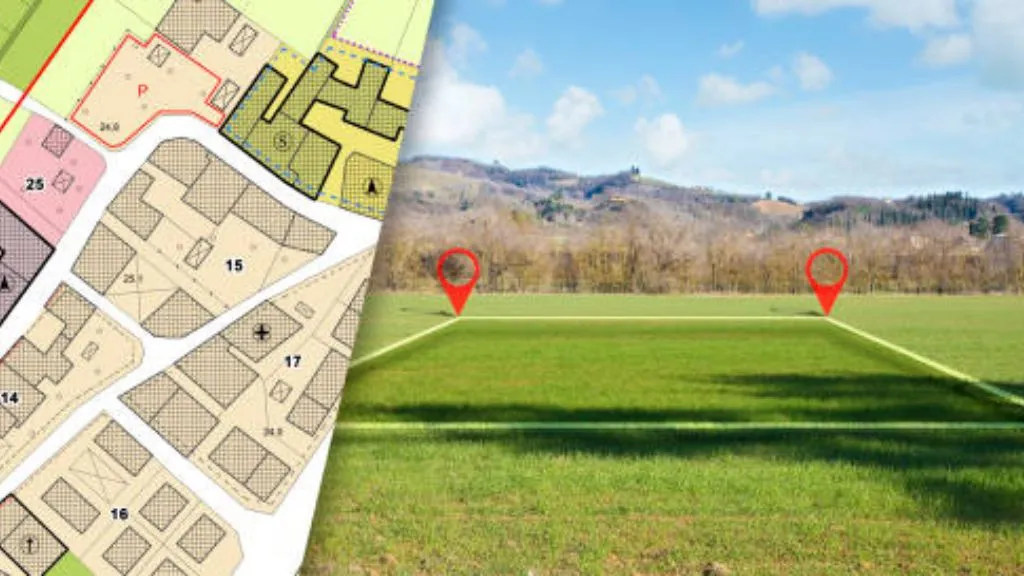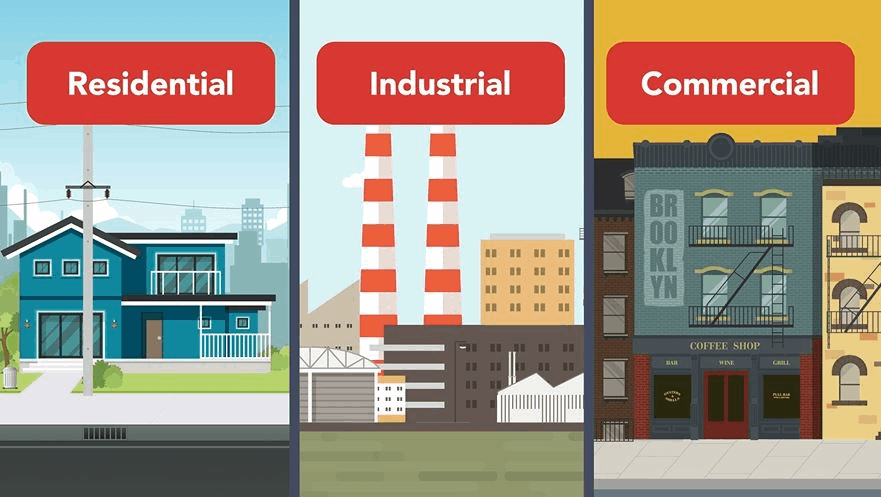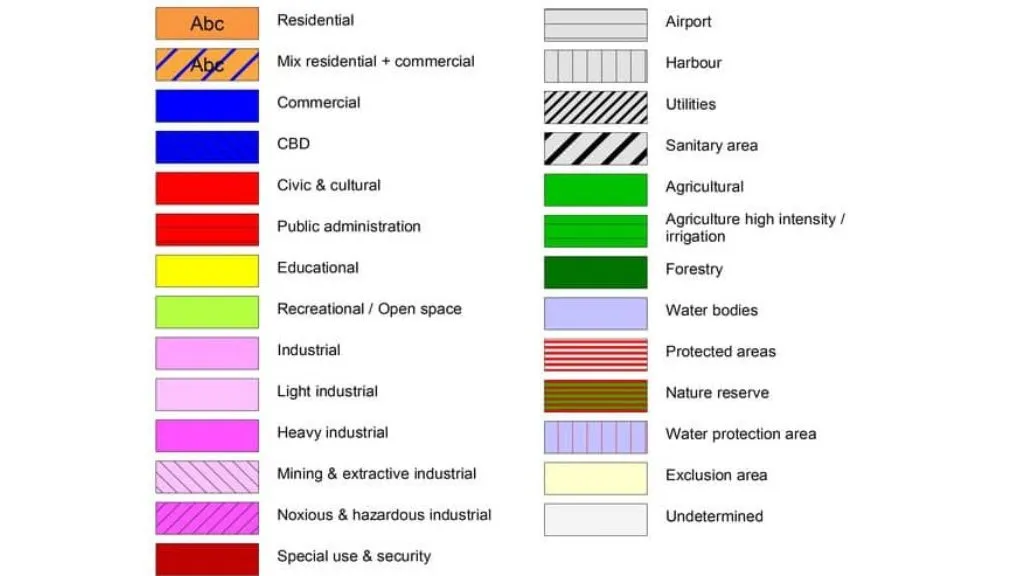
Zoning is a fundamental aspect of urban planning that shapes the way land is used and developed. In real estate, zoning regulations determine how a property can be utilized—be it for residential, commercial, industrial, or mixed-use purposes.
Understanding zoning laws is essential for property buyers, investors, and developers to avoid legal issues and maximize a property’s potential. In this article, we will explore what zoning in real estate means, its types, and how it impacts property development and investment decisions.
Let’s understand the term a step further with this article!
What are the 8 Different Types of Zoning In Real Estate?

A zoning category in one city may not represent the same in another. Local authorities use alphabets to identify the purpose of each zone such as
- I for industrial
- C for commercial
- R for residential
These alphabets are paired with a number that indicates the level of use, the square footage for that particular property, or the amount of acreage. Let’s break down each type for a better understanding.
1. What is Residential Zoning?
Residential zoning covers issues such as the number of structures allowed on a certain piece of land or whether mobile homes can be placed on a particular property. Residential zones include
- Suburban Homesteads (SH)
- Angle Family Residences (SFR)
- Other designations such as condominiums, co-ops, trailer parks, duplexes, apartments, and homes
Residential zoning laws typically prohibit pets in the area but they allow domesticated animals such as cows, pigs, horse, or sheep subjected under certain requirements. Most laws do not allow farm animals on residential properties while others limit animals based on the size of the piece of land.
Can you run a business from your residential property? Home-based businesses in residential zones are subject to these details
- Noise issues
- Parking and delivery concerns
- Signage
- Hours of operation
- Business or employees invitees
- Nature of the business
Not all zoning regulations allow home-based businesses to run in residential zones while the ones that allow will decide on the basis of the business hours and the nature of the business. Home-based regulations for condos are more stringent than private residences.
2. What is Commercial Zoning?
Commercial zoning depends on the type of business run on the peropety and the numbero f patrons involved except single family lots and homes, all types of real estate is considered commercial. Here are some examples of commercial zones:
- Certain warehouses
- Hotels
- Nightclubs
- Shopping centres
- Offices
Some vacant land and apartment complexes that might turn into one of the above mentioned commercial zones also come under commercial zoning laws. These zones also depend on the parking availability in the property. Only certain commercial laws allow businesses to be closer to each other and they ban adult entertainment establishments in particular geographical areas (i.e., nowhere near schools or churches).
3. What is Industrial Zoning?
Industrial zoning laws are business-specific and include aerovent factors like noise and wastage management concerns. Here are some examples of Industrial zones:
- Storage facilities
- Manufacturing plants
- Airports
Industrial zoning also depends majorly on floor area ratio and the height if the buildings on a lot. The set-back requirements for industrial zones are higher than other types of zoning.
4. What is Agricultural Zoning?
Agricultural zoning ordinances restrict all non-farm uses of land except dwelling. They set aside a large minimum lot for a residential unit and protect farming communities that are being dismantled by residential developments. The density of development in agricultural zones vary depending upon the type of agriculture. Most states recognize only agricultural zones for
- Additional tax abatement programs
- Subsidy programs
- Federal voluntary incentive programs
5. What is Rural Zoning?
Rural zones are often ranches or farms but in certain parts of the country, this type of zoning also includes residential zones that have been allowed to have cattle or horses. There is no maximum or minimum size for a rural zone and they typically mean a building on agricultural land that is located outside urban developmental boundary. The primary use of rural zones are residential rather than agricultural.
6. What is Combination Zoning?
Combination zones are a mixture of different types of zoning serving mixed purposes. The combination zoning laws permit a particular property to have a mix of Industrial, commercial, and/or residential uses. It can be of 3 main forms:
- Vertical mixed-use that allows a combination of different purposes in the bottom portion of a residential building
- Horizontal mixed-use that allows different purposes on separate parcels of a particular district or area to be combined into one (this comes in handy when different uses have different regulatory or safety requirements)
- Mixed-wise walkable allows a combination of horizontal and vertical mixed-use to create an area of single and mixed-use buildings close together
7. What is Historic Zoning?
Buildings over 50 years of age come under historic zones where the laws does not allow any changes to the original condition of the said building. There will, however, be allowances for restoration and repair all the while staying qualified for government tax incentives. The National register of Historic Places maintains a list of these cultural places and coordinates and supports private and/or public efforts to identify, evaluate, and protect historic zones.
Here’s what the list typically contains from the from the US history, culture, engineering, archeology, and architecture:
- Objects
- Structures
- Buildings
- Sites
- Districts
Property owners of historic zones can submit an application in the National register and can stand eligible for 20% investment tax credit. This credit can be combine with a straight-line depreciation period of
- 31.5 years for non-residential property
- 27.5 years for residential property
The credit is further reduced by the amount of tax credit claimed.
8. What is Aesthetic Zoning?
Aesthetic zones are buildings that are approved by an architectural review committee. These zones have become popular in upscale communities and cover the following aspects
- Types of material
- Satellite dishes
- Decks
- Solar panels
- Fences
- Mailboxes
- Landscaping
- Color schemes
Here is a list of different types of zones you can identify in your neighbourhood:
- Residential for housing
- Commercial for offices
- Retail for malls or high-street complexes
- Agricultural for farming
- Public and semi-public for infrastructure development
- Utilities and services for installing basic facilities
- Industrial for heavy industries, factories, and manufacturing units
- Parks and playground for green open spaces
Mixed land use for urbanized development
The Importance of Different Types of Zoning
Now that we understand the different types of zoning in real estate, let us go an inch further to learn of its highlights and importance:
- Zoning can be used to visibly demarcate lands based on their purpose by using the zoning codes.
- The process of zoning stops reckless and unregulated construction of properties that is not conducive to a specific zone.
- The intact zoning segregation makes sure that the land is being used for the purposes that was stated during zoning and not for a different one.
What Does Zoning Colours Mean?

Development authorities make use of land maps to notify zones and their usage pattern. Zones are marked using colours on the maps for graphically displaying its uses, nearby roads, public infrastructure, and community facilities.
Here’s a tabular explanation of what these colours mean.
| Colors | Significance of the Colors on the Zoning Map |
| Light yellow | Main or mixed residential use of land |
| Dark yellow | For mixed industrial use and essential services like stores, clinics, and around 33% of commercial activity |
| Green | Just like the color, significance of greenery or agricultural land. Shades to differentiate between valleys, forests, ponds, etc |
| Red | Public and semi-public use of area like garden, worship places, etc |
| Light blue | Commercial purpose like central business, offices, etc |
| Dark blue | Retail purpose like malls, hotels, cinema, etc |
| Light violet | Individual purpose and establishment |
| Dark violet | High-tech industries |
| Gray | Heavy industries |
A Final Word: The Importance of Land Zoning in India
Indian civic authorities are making use of Euclidean-based zoning to classify the usage of land or a particular geographical area. Different types of zoning includes residential, multi-family, single-family, commercial, and others.
The process of zoning has taken an integrated course because of the ever-increaseing dearth of land in India. For instance – the use of a mixed residential zone allows what was allowed in primarily residential zones, like banks, restaurants, shops, bakeries, etc. On the other hand, the commercial land use zone allows all in the primary residential and mixed residential zones.
Issues with zoning laws may arise an time and may affect your freedom to do what you please on yoru land. You may petition to enforce zoning on your poetry nder specific circumstances. Reach out to a zonin attorenry experienced in land use laws to clear your questions on what you can do on your land.
Different Types Of Zoning In The Real Estate FAQs:
1) What are the various types of zoning in real estate ?
1. Residential
2. Commercial
3. Industrial
4. Mixed-use
5. Agricultural






